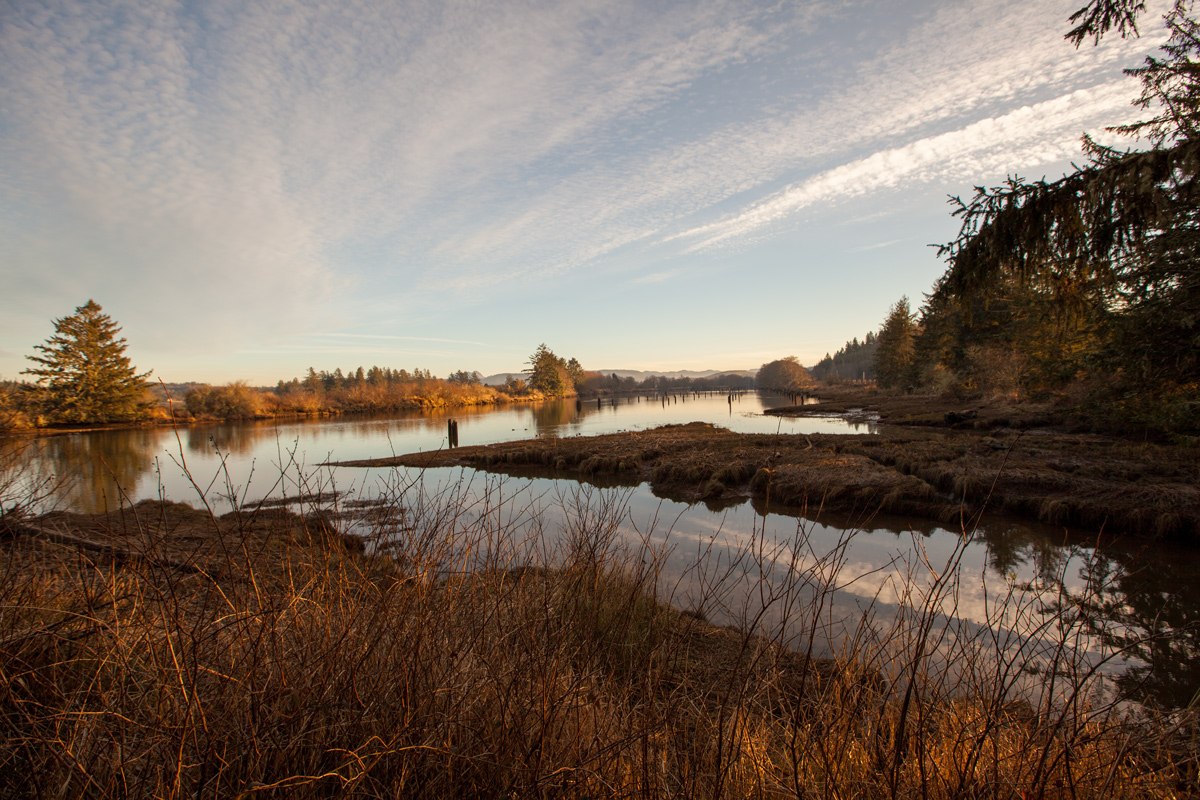The captains adopt the Clatsop word to name the Netul—present Lewis and Clark River, and Lewis describes the Oregon crabapple tree. Pvts. Howard and Werner arrive at Fort Clatsop with a fresh supply of salt and report the salt makers are “much straitened for provision”. Due to fresh snow, only three of yesterday’s killed elk can be found.
Sunset on the Netul River
Fort Clatsop National Historic Park
© 18 January 2013 by Kristopher K. Townsend. Permission to use granted under the Creative Commons Attribution-Share Alike 4.0 International license.
Naming the Netul River
the river on which Fort Clatsop stands we now call Ne-tul, this being the name by which the Clatsops call it.
—Meriwether Lewis
Oregon Crabapple Tree
The wood of this tree is excessively hard when seasoned. the natives make great uce of it to form their wedges with which they split their boards of pine for the purpose of building houses. these wedges they also employ in spliting their fire-wood and in hollowing out their canoes. I have seen the natives drive the wedges of this wood into solid dry pine which it cleft without fracturing or injuring the wedge in the smallest degree. we have also found this wood usefull to us for ax handles as well as glutts or wedges.
—Meriwether Lewis
Straitened for Provisions
about noon Howard and Werner returned with a supply of salt; the badness of the weather and the difficulty of the road had caused their delay. they inform us that the salt makers are still much straitened for provision, having killed two deer only in the last six days; and that there are no Elk in their neighourhood.
—Meriwether Lewis
Lost Elk
We set out from the fort early, and arrived where they had left those Elk. The hunters that had killed these Elk were with me. We could find only three of them, the Snow having covered them. We returned with the Meat of these 3 Elks in the Evening to the fort. I got during this day my feet severely frost bit.—
—Joseph Whitehouse
Weather Diary
aspect of the weather at rise
Wind at rise
Weather at 4 OC. P.M. Wind at 4 OC. P.M. fair N E fair N. E last night exposed a vessel of water to the air with a view to discover the debth to which it would freiz in the course of the night, but unfortunately the vessel was only 2 inches deep and it feized the whole thickness; how much more it might have frozen had the vessel been deeper is therefore out of my power to decide. it is the couldest night that we have had, and I suppose the murcury this morning would have stood as low as 15° above 0.—
—Meriwether Lewis[1]To assist the reader, the editor of this web page has omitted the “Day of the month” column and spelled out some abbreviations.
Experience the Lewis and Clark Trail
The Lewis and Clark Trail Experience—our sister site at lewisandclark.travel—connects the world to people and places on the Lewis and Clark Trail.
Plan a trip related to January 28, 1806:

Fort Clatsop is a High Potential Historic Site along the Lewis and Clark National Historic Trail managed by the U.S. National Park Service. The site is managed by the Lewis and Clark National and State Historic Parks.
Notes
| ↑1 | To assist the reader, the editor of this web page has omitted the “Day of the month” column and spelled out some abbreviations. |
|---|




